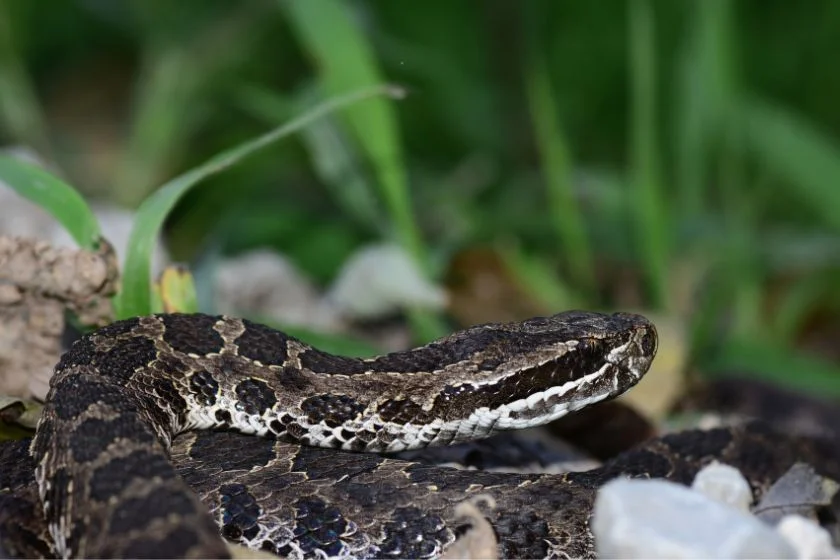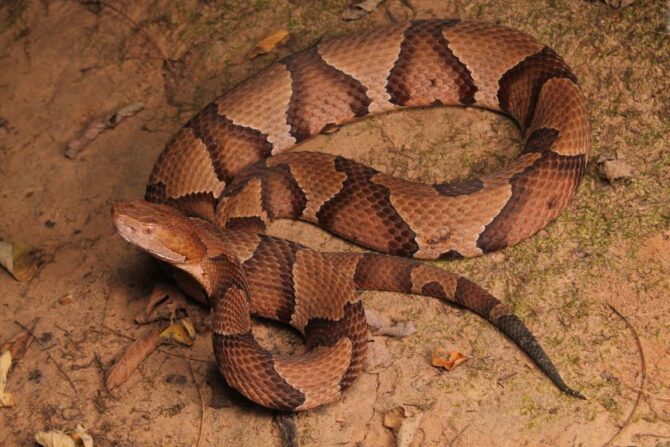Like every other state in the United States, Michigan has its share of wildlife, thanks to the abundance of habitats these animals can live in.
Amongst these animals are a variety of snake species.
Non-venomous snakes in Michigan constitute the majority, which is good news as it reduces the chances of getting bit.
The only poisonous species in the state is the Eastern Massasauga, a rattlesnake with a strong bite.
Let’s explore this species and all you need to know.
How Many Snakes Are in Michigan?
Michigan is home to 18 different snake species, 17 of which are non-venomous.
They come in different sizes and are found in varying locations.
Because the overwhelming majority is non-venomous, snakes in Michigan are harmless and would rather avoid you than start a “fight.”
Some of these non-venomous snakes look like poisonous species, making some people skeptical.
An example is the non-venomous northern watersnake, which looks like the highly venomous cottonmouth. However, there are no cottonmouths in Michigan.
Another species that comes across as poisonous is the eastern hog-nosed snake.
While it bears no similarities with a poisonous snake, the eastern hog-nosed responds to feelings of threat by baring its fangs.
Then we have the blue racer. Unlike other snakes that avoid humans, the blue racer seems keen on chasing people and may even be aggressive. This should lead you to avoid it, but it isn’t venomous.
Venomous Snakes in Michigan
Eastern Massasauga (Sistrurus catenatus)

- Size: 24 to 30 inches
- Habitat: Swamps, marshes, grasslands
- Identifying Features: Grey or tan color, brown or black spots
- Behavior: Shy, avoidant
- Threats: Hemotoxin, cytotoxin
The only venomous snake in Michigan is the eastern massasauga, a native of North America, making it the most dangerous species in the state.
This species lives in swamps, marshes, and grasslands. It can be found both in Canada and the United States, extending beyond Michigan.
The eastern massasauga’s venom is known to destroy tissue because of the cytotoxin contained.
The venom can also cause internal bleeding, especially on small prey. The Massasauga tends to avoid humans and isn’t aggressive, which reduces the chances of getting bit.
Biting cases occurred when the victim accidentally stepped on the snake or handled it. Symptoms of the bite include swelling, strong pain, and nausea.
The Eastern Massasauga is toxic, but bites are rare and fatal cases even more. Only two fatalities have been reported.
Are You in Danger of Snakebite in Michigan?
Given that there’s only one shy poisonous snake, you may go through Michigan without encountering it or getting bit.
The state is a relatively safe place when it comes to snakes, which is good news for many wildlife explorers. Nevertheless, you should take extra precautions.

When exploring swamps, marshes, or any other habitat that the massasauga might be in, ensure you wear adequate footwear and long pants. Also, watch where you step.
Do not try to handle these snakes too–or any other species as that makes them more likely to bite. If you ever meet one, stay away from it.
Other Venomous Snakes in the United States
Generally, there are four genera of venomous snakes in the United States.
These are the rattlesnakes, cottonmouths, copperheads, and coral snakes. The massasauga is a rattlesnake, as stated above.
Though its name doesn’t portray that it is one, it shares all characteristics of a rattlesnake, including the rattle. They also come with patterns.
The longest rattlesnake is the eastern diamondback. Many rattlesnakes are shy creatures, but they constitute the most dangerous snakes in the world.

The next one is the copperhead. It is very common in the United States, though it is not found in Michigan.
There are eight species under this genus, the most notable being the eastern copperhead. Its venom is not as potent as the rattlesnake but still has effects.

The cottonmouth is closely related to the copperhead and goes by other names like the swamp moccasin and the black mocassin.
It is native to the United States, though absent from Michigan. The cottonmouth is more dangerous than the copperhead but isn’t at the level of rattlesnakes.
The final category is the coral snake, a large group of snakes in the Elapidae family.
This category is subdivided into the Old World and the New World. The latter is found in the Americas.
They are quite rare in the United States. Their bites are also not fatal but dangerous nonetheless.
Final Thoughts
Many states in the US have three or more poisonous snakes, but the only venomous snake in Michigan is the Massasauga.
This is good news because avoiding a snake bite is easier in this state.
However, you should be cautious around swampy habitats and not touch any snake you see, even if it’s a non-venomous species.






